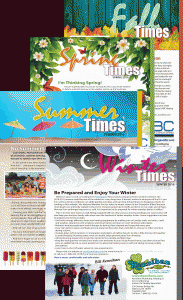
As the importance of the Internet grows, especially social media, the amount of dollars spent in that media grows as well. Marketers across the nation have been redirecting their dollars to the electronic and digital world in larger percentages since 2007. In fact, many studies point out that print media began its decline in that same year.
This sea-change certainly has added to the clutter that consumers get in their email boxes, as well as the sometimes bothersome plethora of notifications via Facebook, Twitter, and other social media outlets. With this migration, believe it or not, an interesting phenomenon has been occurring: printed material, especially of the newsletter variety, is getting excellent traction, once again, as communications vehicles. A number of studies have been done over the years that show printed newsletter use and popularity is on the rise.
Some facts: According to the 2014 Business-to-Consumer (B2C) and Business-to-Business (B2B) Content Marketing Benchmarks, Budgets, and Trends report for North America, B2C marketers use print newsletters with greater frequency at 29% compared to their B2B counterparts at 22%. In addition, customer retention/loyalty is cited as a top marketing goal for B2C compared to lead generation for B2B.
In other words, a print newsletter is an easy and effective way to increase retention rates, increase referrals, and instantly build long-lasting relationships with your clients. In an article on the Newsletter Pro Website, they say that printed newsletters are “a surefire way to stay ‘top of mind’ and your clients are more likely to pass along a name they actually remember (hint: yours). On top of that, because a print newsletter is a physical object, it can easily be picked up and passed around – which is exactly what your clients will do with it. When you send out a monthly print newsletter, you’re automatically reaching new customers way beyond your mailing list.”
In another study, Epsilon Targeting’s Consumer Channel Preference Study, findings show that print newsletters (which fit into the category of direct mail) continues to deliver as consumers’ preferred means of receiving marketing messages from brands. Some food for thought:
- Six of 10 U.S. consumers surveyed say they “enjoy getting postal mail from brands about new products” and services
- Direct mail (includes print newsletters) is preferred over email by ALL respondents
- A natural inclination for direct mail includes the 18 to 34-year-old demographic
- Half of all respondents concur with the statement, “I pay more attention to information I receive by postal mail than if it was received by email.”
One reason: getting a printed communications piece in the mail has become more unique than getting one in your inbox. This means you have a better chance of really capturing more of your customers’ attention through printed newsletters.
Another fact: Direct mail still holds a 43% share of total retail advertising, and 76% of small businesses say their ideal marketing strategy involves both digital and print marketing efforts. Read more about this at Business2Community.com.
The studies have also found that the power of the Internet is particularly strong in the beginning stages of the buying cycle. But printed newsletters are now important when it comes to customer retention and loyalty. It’s through this vehicle that customers can receive useful information on a regular basis – information they notice and read. This is of value to them and positions your company as a thought leader in the marketplace.
The Helpful Expert
Human behavior is a funny thing: the truth is that people are more likely to believe that you can help them if they see you as an expert, which in turn, increases the likelihood that they’ll hire you. For example, you wouldn’t choose a model plane hobbyist to work on the throttle controls of your aircraft — you’d choose an experienced aircraft mechanic, right?
Newsletters are one of the simplest and most effective ways to establish this expertise. Flashy advertisements, fancy “look-at-me” websites, and glossy brochures mostly are all about selling, newsletters are about educating, guiding, and advising, which is what experts do. In other words, newsletters are about helping. They become an extension of your services, a place where people get a taste of what you offer. At the same time, printed newsletters keep your name before your public. They are a regular reminder that you are able and available to help.
Experts, like the folks at the Content Marketing Institute, will tell you that to use newsletters in this way they need to do and contain a number of key content. They say you should:
- Fill your newsletter with helpful information that readers can use in their lives. Give suggestions, new ideas, “how-to’s,” warnings, resources, tools, or advice. Include brief information about your services, but avoid self-promotion; keep it focused on the benefits of your services
- Make the newsletter relevant. Whether it is about energy efficiency, safety, indoor air quality, or what to do in an emergency, make the newsletter current, relevant, and helpful to your audience
- Send out your newsletter consistently and regularly. That can be quarterly, monthly, or every other month. This builds trust and confidence that people can rely on you. It also keeps you in front of your marketplace
- Make your newsletter look professional and include well-written articles. A badly designed or written newsletter can actually do more harm than good, reflecting poorly on you. If writing isn’t your strength, or you don’t have the skills to design and layout a newsletter (don’t want to take the time to learn them), then outsource. You don’t have to do everything yourself
- Send your newsletter to past clients, referral sources, and anyone who asks about your services. Also leave free copies of your hard copy newsletter in the offices of your referral sources and other locations, such as your local library, community center or coffee shop — or wherever the people who can use your particular services gather
- Use your newsletter in conjunction with or instead of your business card. Your newsletter will have everything on it that a business card does: name, contact info, logo, etc. But it provides far more than a card. Consumers will connect the expert material in your newsletter to you, the person, not just a name
- Post your newsletter online. Yes, it’s a print product. But that doesn’t mean you shouldn’t leverage the Internet as well. For example, posting your newsletter online can help attract potential clients who find you through an Internet search.
Newsletters are “Actionable”
Articles in your newsletters should all have some kind of call to action. That could mean phone numbers or email addresses where the reader can get more information. It can include source web addresses for consumers to fact check, if they want. You do want your newsletters to be more informative and less “sales-y,” but you should still have some promotions in them. For example, you can include a coupon for dollars-off certain services, or specials on clean-and-checks.
You can include QR Codes as well. The QR code was first used back in 1994, and since has become a great way to advertise your website in print media. Instead of listing your URL, use a QR code that smartphone users can scan and go directly to a page on your website.

As we said earlier, this may seem overwhelming, but it doesn’t have to be. You can opt out of doing newsletters yourself and farm them out to professional organizations that will do it for you. There are a lot of resources out there, but before hiring any of them, here are some of the services they should offer:
- Simple subscriber/audience management—This service eliminates the need for you to manually go through and delete or add new contacts. In addition, a good newsletter provider can divide your email list up into segments based on information from subscribers such as date of sign up, pages viewed, interests, etc.
- Proven Design Services – Does design make a difference? You betcha! What does the service do that entices potential readers to open the newsletter and read it? Is HTML the answer? These are questions the provider should be able to answer without question
- Electronic versions – Does the service provide you electronic (digital) versions of the newsletter that you can use in email campaigns as well? Will they provide the HTML so you can actually publish it on your website?
- Writing and Editing — Most services provide this, but their content is extremely generic in nature. So either you have to re-edit their stories to make them pertinent to your audience or work with companies within your industry that can provide industry-specific stories.
Speaking of having an industry specific focus, as members of the National Comfort Institute, you have access to a service called, ContractorsImage™ (CI) which is the marketing arm of NCI. ContractorsImage provides a turnkey approach to well-designed and well-written print newsletters by HVAC Industry professionals for your customers. Plus you have the opportunity to customize parts of the newsletter to make it even more pertinent to them and your business.
If you’re interested in learning more about CI and our newsletter services, please contact Connie Conklin at 800-633-7058 or email her at Conniec@ncihvac.com.
Remember, no one may be talking about print marketing anymore, but that’s not necessarily a bad thing. While companies battle for attention online, you can reach customers offline in a professional format that may give you one more marketing leg-up over your competitors.
